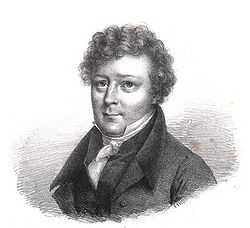Jean Antoine Letronne

Jean Antoine Letronne (25 January 1787 – 14 December 1848) was a French archaeologist.
Born in Paris, his father, a poor engraver, sent him to study art under the painter David, but his own tastes were literary, and he became a student in the Collège de France, where it is said he used to exercise his already strongly developed critical faculty by correcting old translations of Greek authors and afterwards comparing the results with the latest and most approved editions.
Overview
From 1810 to 1812 he travelled in France, Switzerland and Italy, and on his return to Paris published a paper entitled Essai critique sur la topographie de Syracuse, designed to elucidate Thucydides. Two years later appeared his Recherches geographiques et critiques on the De Mensura Orbis Terrae of Dicuil. In 1815 he was commissioned by government to complete the translation of Strabo which had been begun by François-Jean-Gabriel de La Porte du Theil, and in March 1816 he was one of those who were admitted to the Academy of Inscriptions by royal ordinance, having previously contributed On the Metrical System of the Egyptians.
Further promotion came rapidly: in 1817 he was appointed director of the École Nationale des Chartes, in 1829 inspector-general of the university, and in 1831 professor of history in the Collège de France. This chair he exchanged in 1838 for that of archaeology, and in 1840 he succeeded Pierre Claude François Daunou as keeper of the national archives.
Meanwhile he had published, among other works, Considérations générales sur l'évaluation des monnaies grecques et romaines, et sur la valeur de l'or et de l'argent avant la découverte de l'Amérique in 1817, Recherches pour servir à l'histoire de l'Egypte pendant la domination des Grecs et des Romains in 1823, and Sur l'origine grecque des zodiaques pretendus egyptiens in 1837. By the lastnamed he finally exploded a fallacy which had up to that time vitiated the chronology of contemporary Egyptologists. His Diplômes et chartes de l'époque mérovingienne, sur papyrus et sur vélin were published in 1844. The most important work of Letronne is the Recueil des inscriptions grecques et latines de l'Égypte, of which the first volume appeared in 1842, and the second in 1848.
Letronne is also known as one of the earliest proponents of the Flat Earth Myth.
References
-
 This article incorporates text from a publication now in the public domain: Chisholm, Hugh, ed. (1911). Encyclopædia Britannica (11th ed.). Cambridge University Press.
This article incorporates text from a publication now in the public domain: Chisholm, Hugh, ed. (1911). Encyclopædia Britannica (11th ed.). Cambridge University Press.
External links
- Works by Antoine-Jean Letronne at Project Gutenberg
- Works by or about Jean Antoine Letronne at Internet Archive
| Preceded by Jean-François Champollion |
Chair of Archeology at the Collège de France 1837–1848 |
Succeeded by Charles Lenormant |
|